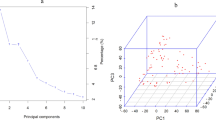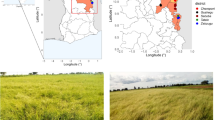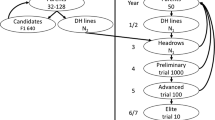Abstract
Hexaploid bread wheat evolved from a rare hybridisation, which resulted in a loss of genetic diversity in the wheat D-genome with respect to the ancestral donor, Aegilops tauschii. Novel genetic variation can be introduced into modern wheat by recreating the above hybridisation; however, the information associated with the Ae. tauschii accessions in germplasm collections is limited, making rational selection of accessions into a re-synthesis programme difficult. We describe methodologies to identify novel diversity from Ae. tauschii accessions that combines Bayesian analysis of genotypic data, sub-species diversity and geographic information that summarises variation in climate and habitat at the collection point for each accession. Comparisons were made between diversity discovered amongst a panel of Ae. tauschii accessions, bread wheat varieties and lines from the CIMMYT synthetic hexaploid wheat programme. The selection of Ae. tauschii accessions based on differing approaches had significant effect on diversity within each set. Our results suggest that a strategy that combines several criteria will be most effective in maximising the sampled variation across multiple parameters. The analysis of multiple layers of variation in ex situ Ae. tauschii collections allows for an informed and rational approach to the inclusion of wild relatives into crop breeding programmes.




Similar content being viewed by others
References
Allen AM, Barker GLA, Berry ST, Coghill JA, Gwilliam R, Kirby S, Robinson P, Brenchley RC, D’Amore R, McKenzie N, Hall A, Bevan M, Hall N, Edwards KJ (2011) Transcript-specific, single-nucleotide polymorphism discovery and linkage analysis in hexaploid bread wheat (Triticum aestivum L.). Plant Biotechnol J 9:1086–1099
Allen AM, Barker GLA, Wilkinson P, Burridge A, Winfield M, Coghill J, Uauy C, Griffiths S, Jack P, Berry S, Werner P, Melichar JPE, McDougall J, Gwilliam R, Robinson P, Edwards KJ (2013) Discovery and development of exome-based, co-dominant single nucleotide polymorphism markers in hexaploid wheat (Triticum aestivum L.). Plant Biotechnol J 11(3):279–295. doi:10.1111/pbi.12009
Beales J, Turner A, Griffiths S, Snape JW, Laurie DA (2007) A pseudo-response regulator is misexpressed in the photoperiod insensitive Ppd-D1a mutant of wheat (Triticum aestivum L.). Theor Appl Genet 115:721–733
Bentley AR, Turner AS, Gosman N, Leigh FJ, Maccaferri M, Dreisigacker S, Greenland A, Laurie DA (2011) Frequency of photoperiod-insensitive Ppd-A1a alleles in tetraploid, hexaploid and synthetic hexaploid wheat germplasm. Plant Breed 130:10–15
Bhullar NK, Street K, Mackay M, Yahiaouia N, Kellera B (2009) Unlocking wheat genetic resources for the molecular identification of previously undescribed functional alleles at the Pm3 resistance locus. Proc Natl Acad Sci USA 106:9519–9524
Brevis JC, Morris CF, Manthey F, Dubcovsky J (2010) Effect of the grain protein content locus Gpc-B1 on bread and pasta quality. J Cereal Sci 51:357–365
Campana MG, Hunt HV, Jones H, White J (2010) CorrSieve: software for summarizing and evaluating Structure output. Mol Ecol Resour 11:340–352
Dubcovsky J, Dvorak J (2007) Genome plasticity a key factor in the success of polyploid wheat under domestication. Science 316:1862–1866
Dudnikov AJ (2011) Chloroplast DNA non-coding sequences variation in Aegilops tauschii Coss.: evolutionary history of the species. Genet Resour Crop Evol 59:683–699
Dvorak J, Zhang HK (1992) Reconstruction of the phylogeny of the genus Triticum from variation in repeated nucleotide sequences. Theor Appl Genet 84:419–429
Dvorak J, Luo MC, Yang ZL, Zhang HB (1998a) The structure of the Aegilops tauschii genepool and the evolution of hexaploid wheat. Theor Appl Genet 97:657–670
Dvorak J, Luo M-C, Yang Z-L (1998b) Genetic evidence on the origin of Triticum aestivum L. In: Damania AB, Valkoun J, Willcox G, Qualset CO (eds) The origins of agriculture and crop domestication (The Harlan Symposium). ICARDA, Aleppo, pp 235–251
Endresen DTF (2010) Predictive association between trait data and ecogeographic data for Nordic Barley Landraces. Crop Sci 50:2418–2430
Endresen DTF, Street K, Mackay M, Bari A, De Pauw E (2011) Predictive association between biotic stress traits and ecogeographic data for wheat and barley landraces. Crop Sci 51:2036–2055
ESRI (2011) ArcGIS Desktop: Release 10. Environmental Systems Research Institute, Redlands
Eujayl I, Sorrells M, Baum M, Wolters P, Powell W (2002) Isolation of EST-derived microsatellite markers for genotyping the A and B genomes of wheat. Theor Appl Genet 104:399–407
Feldman M, Lupton FGH, Miller TE (1995) Wheats. In: Smartt J, Simmonds NW (eds) Evolution of Crops. Longman Scientific, London, pp 184–192
Feuillet C, Langridge P, Waugh R (2008) Cereal breeding takes a walk on the wild side. Trends Genet 24:24–32
Fulton TM, Chunwongse J, Tanksley SD (1995) Microprep protocol for extraction of DNA from tomato and other herbaceous plants. Plant Mol Biol Rep 13:207–209
Giles RJ, Brown TA (2006) GluDy allele variations in Aegilops tauschii and Triticum aestivum: implications for the origins of hexaploid wheats. Theor Appl Genet 112:1563–1572
Gupta PK, Balyan HS, Edwards KJ, Isaac P, Korzun V, Röder M, Gautier M-F, Joudrier P, Schlatter AR, Dubcovsky J et al (2002) Genetic mapping of 66 new microsatellite (SSR) loci in bread wheat. Theor Appl Genet 105:413–422
Hamblin MT, Warburton ML, Buckler ES (2007) Empirical comparison of simple sequence repeats and single nucleotide polymorphisms in assessment of maize diversity and relatedness. PLoS One 2:e1367. doi:10.1371/journal.pone.0001367
Heywood V (2011) Introductory and Background Material. In: Hunter D, Heywood V (eds) Crop Wild Relatives: A Manual of in situ Conservation. London and Washington Earthscan in Association with Biodiversity International, pp 3–30. ISBN 9781849711791
Hijmans RJ, Jacobs M, Bamberg JB, Spooner DM (2003) Frost tolerance in wild potato species: assessing the predictivity of taxonomic, geographic, and ecological factors. Euphytica 130:47–59
Hübner S, Höffken M, Oren E, Haseneyer G, Stein N, Graner A, Schmid K, Fridman E (2009) Strong correlation of wild barley (Hordeum spontaneum) population and precipitation variation. Mol Ecol 18:1523–1536
IUCN (1974) Uvardy MDF. A classification of the biogeographical provinces of the world. IUCN occasional paper No 18, International Union for Conservation of Nature, Gland, Switzerland
Jiang J, Friebe B, Gill BS (1994) Recent advances in alien gene transfer in wheat. Euphytica 73:199–212
Jones H, Lister DL, Bower MA, Leigh FJ, Smith LM, Jones MK (2008) Approaches and constraints of using existing landrace and extant plant material to understand agricultural spread in prehistory. Plant Genet Resour 6:98–112
Jones H, Civáň P, Cockram J, Leigh FJ, Smith LMJ, Jones MK, Charles MP, Molina-Cano J-L, Powell W, Jones G, Brown TA (2011) Evolutionary history of barley cultivation in Europe revealed by genetic analysis of extant landraces. BMC Evolut Biol 11:320. http://www.biomedcentral.com/1471-2148/11/320
Kilian B, Graner A (2012) NGS technologies for analyzing germplasm diversity in genebanks. Briefings Funct Genomics. doi:10.1093/bfgp/elr046
Kishii M, Delgado R, Rosas V, Cortes A, Cano S, Sanchez J, Mujeeb-Kazi A (2007) Exploitation of Genetic Resources through Wide Crosses. Proceedings International Symposium on wheat Yield Potential CIMMYT, Mexico
Knaggs P, Ambrose MJ, Reader S, Miller TE (2000) Morphological characterization and evaluation of the subdivision of Aegilops tauschii Coss. Wheat Inform Serv 91:15–19
Liu K, Muse SV (2005) Powermarker: integrated analysis environment for genetic marker data. Bioinformatics 21:2128–2129
Matsuoka Y (2011) Evolution of polyploid triticum wheats under cultivation: the role of domestication, natural hybridization and allopolyploid speciation in their diversification. Plant Cell Physiol 52:750–764
Maxted N, Kell SP (2009) Establishment of a global network for the in situ conservation of crop wild relatives: status and needs. FAO Commission on Genetic Resources for Food and Agriculture, Rome
Maxted N, White K, Valkoun J, Konopka J, Hargreaves S (2008) Towards a conservation strategy for Aegilops species. Plant Genetic Resour Charact Utilization 6:126–141
Mizuno N, Yamasaki M, Matsuoka Y, Kawahara T, Takumi S (2010) Population structure of wild wheat D-genome progenitor Aegilops tauschii Coss: implications for intraspecific lineage diversification and evolution of common wheat. Mol Ecol 19:999–1013
Moragues M, Comadran J, Waugh R, Milne I, Flavell AJ, Russell JR (2010) Effects of ascertainment bias and marker number on estimations of barley diversity from high-throughput SNP genotype data. Theor Appl Genet 120:1525–1534
Mujeeb-Kazi A, Gul A, Ahmad I, Farooq M, Rizwan S, Bux H, Iftikhar S, Asad S, Delgado R (2007) Aegilops tauschii, as a spot blotch (Cochliobolus sativus) resistance source for bread wheat improvement. Pak J Bot 39:1207–1216
New M, Lister D, Hulme M, Makin I (2002) A high-resolution data set of surface climate over global land areas. Clim Res 21:1–25
Peeters JP, Wilkes HG, Galwey NW (1990) The use of ecogeographical data in the exploitation of variation from gene banks. Theor Appl Genet 80:110–112
Pestsova E, Korzun V, Goncharov NP, Hammer K, Ganal MW, Röder MS (2000) Microsatellite analysis of Aegilops tauschii germplasm. Theor Appl Genet 101:100–106
Prada D (2009) Molecular population genetics and agronomic alleles in seed banks: searching for a needle in a haystack? J Exp Bot 60:2541–2552
Pritchard JK, Stephens M, Donnelly P (2000) Inference of population structure using multilocus genotype data. Genetics 155:945–959
Reynolds M, Trethowan RM (2007) Physiological interventions in breeding for adaptation to abiotic stress. In: Spiertz JHJ, Struik PC, Van Laar HH (eds) Scale and complexity in plant systems research, gene-plant-crop relations. Springer, The Netherlands
Reynolds M, Dreccer F, Trethowan R (2007) Drought-adaptive traits derived from wheat wild relatives and landraces. J Exp Bot 58:177–186
Röder MS, Korzun V, Wendehake K, Plaschke J, Tixier M-H, Leroy P, Ganal MW (1998) A microsatellite map of wheat. Genetics 149:2007–2023
Sakamoto Y, Ishiguro M, Kitagawa G (1986) Akaike information criterion statistics. D. Reidel Publishing Company, Dordrecht
Sohail Q, Shehzad T, Kilian A, Eltayeb AE, Tanaka H, Tsujimoto H (2012) Development of diversity array technology (DArT) markers for assessment of population structure and diversity in Aegilops tauschii. Breed Sci 62:38–45. doi:10.1270/jsbbs.62.38
Song QJ, Fickus EW, Cregan PB (2002) Characteristics of trinucleotide markers in wheat. Theor Appl Genet 104:286–293
Song QJ, Shi JR, Singh S, Fickus EW, Costa JM, Lewis J, Gill BS, Ward R, Cregan PB (2005) Development and mapping of microsatellite (SSR) markers in wheat. Theor Appl Genet 110:550–560
Trethowan RM, Mujeeb-Kazi A (2008) Novel germplasm resources for improving environmental stress tolerance of hexaploid wheat. Crop Sci 48:1255–1265
Vavilov NI (1957) World resources of cereals, leguminous seed crops and flax and their utilisation in plant breeding. The Academy of Sciences of the USSR. Moscow translated and published by the National Science Foundation, Washington (1960)
Wang J, Luo MC, Chen Z, You FM, Wei Y, Zheng Y, Dvorak J (2013) Aegilops tauschii single nucleotide polymorphisms shed light on the origins of wheat D-genome genetic diversity and pinpoint the geographic origin of hexaploid wheat. New Phytol. doi:10.1111/nph.12164
Acknowledgments
The authors gratefully acknowledge the NIAB Trust and the UK Biotechnology and Biological Sciences Research Council (grants BB/E006868/1, BB/I002561/1, BB/J004596/1, BB/J004588/1) for funding this work. The following germplasm collections provided seed and passport data for the Ae. tauschii accessions, USDA-ARS Small Grains Collection, University of Tokyo, IPK Gatersleben, ICARDA, Kansas State University, John Innes Centre Germplasm Resources Unit and the Vavilov Institute. The authors wish to thank Jon Raupp of the Kansas State University, Steve Reader and Mike Ambrose of the John Innes Centre.
Author information
Authors and Affiliations
Corresponding authors
Additional information
Communicated by J. Dubcovsky.
Electronic supplementary material
Below is the link to the electronic supplementary material.
Rights and permissions
About this article
Cite this article
Jones, H., Gosman, N., Horsnell, R. et al. Strategy for exploiting exotic germplasm using genetic, morphological, and environmental diversity: the Aegilops tauschii Coss. example. Theor Appl Genet 126, 1793–1808 (2013). https://doi.org/10.1007/s00122-013-2093-x
Received:
Accepted:
Published:
Issue Date:
DOI: https://doi.org/10.1007/s00122-013-2093-x




